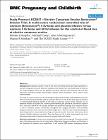| dc.contributor.author | MURPHY, DEIRDRE | en |
| dc.date.accessioned | 2011-09-26T14:53:21Z | |
| dc.date.available | 2011-09-26T14:53:21Z | |
| dc.date.issued | 2009 | en |
| dc.date.submitted | 2009 | en |
| dc.identifier.citation | Murphy DJ, Carey M, Montgomery AA, Sheehan SR, Study protocol. ECSSIT - Elective Caesarean Section Syntocinon Infusion Trial. A multi-centre randomised controlled trial of oxytocin (Syntocinon) 5 IU bolus and placebo infusion versus oxytocin 5 IU bolus and 40 IU infusion for the control of blood loss at elective caesarean section., BMC Pregnancy and Childbirth, 9, 2009, 36- | en |
| dc.identifier.other | Y | en |
| dc.identifier.uri | http://hdl.handle.net/2262/59667 | |
| dc.description | PUBLISHED | en |
| dc.description.abstract | Background:
Caesarean section is one of the most commonly performed major operations in women throughout the world. Rates are escalating, with studies from the United States of America, the United Kingdom, China and the Republic of Ireland reporting rates between 20% and 25%. Operative morbidity includes haemorrhage, anaemia, blood transfusion and in severe cases, maternal death.
The value of routine oxytocics in the third stage of vaginal birth has been well established and it has been assumed that these benefits apply to caesarean delivery as well. A slow bolus dose of oxytocin is recommended following delivery of the baby at caesarean section. Some clinicians use an additional infusion of oxytocin for a further period following the procedure. Intravenous oxytocin has a very short half-life (4?10 minutes) therefore the potential advantage of an oxytocin infusion is that it maintains uterine contractility throughout the surgical procedure and immediate postpartum period, when most primary haemorrhages occur. The few trials to date addressing the optimal approach to preventing haemorrhage at caesarean section have been under-powered to evaluate clinically important outcomes. There has been no trial to date comparing the use of an intravenous slow bolus of oxytocin versus an oxytocin bolus and infusion.
Methods and design:
A multi-centre randomised controlled trial is proposed. The study will take place in five large maternity units in Ireland with collaboration between academics and clinicians in the disciplines of obstetrics and anaesthetics. It will involve 2000 women undergoing elective caesarean section after 36 weeks gestation. The main outcome measure will be major haemorrhage (blood loss >1000 ml). A study involving 2000 women will have 80% power to detect a 36% relative change in the risk of major haemorrhage with two-sided 5% alpha.
Discussion:
It is both important and timely that we evaluate the optimal approach to the management of the third stage at elective caesarean section. Safe operative delivery is now a priority and a reality for many pregnant women. Obstetricians, obstetric anaesthetists, midwives and pregnant women need high quality evidence on which to base management approaches. The overall aim is to reduce maternal haemorrhagic morbidity and its attendant risks at elective caesarean section.
Trial registration:
number: ISRCTN17813715 | en |
| dc.format.extent | 36 | en |
| dc.language.iso | en | en |
| dc.relation.ispartofseries | BMC Pregnancy and Childbirth | en |
| dc.relation.ispartofseries | 9 | en |
| dc.rights | Y | en |
| dc.subject | Gynaecology | en |
| dc.subject | Obstetrics | en |
| dc.subject | Caesarean Section | en |
| dc.subject | Syntocinon | en |
| dc.title | Study protocol. ECSSIT - Elective Caesarean Section Syntocinon Infusion Trial. A multi-centre randomised controlled trial of oxytocin (Syntocinon) 5 IU bolus and placebo infusion versus oxytocin 5 IU bolus and 40 IU infusion for the control of blood loss at elective caesarean section. | en |
| dc.type | Journal Article | en |
| dc.type.supercollection | scholarly_publications | en |
| dc.type.supercollection | refereed_publications | en |
| dc.identifier.peoplefinderurl | http://people.tcd.ie/murphyd4 | en |
| dc.identifier.rssinternalid | 71005 | en |
| dc.identifier.doi | http://dx.doi.org/10.1186/1471-2393-9-36 | en |
| dc.identifier.rssuri | http://www.biomedcentral.com/1471-2393/9/36 | en |




